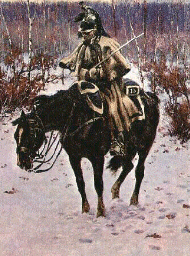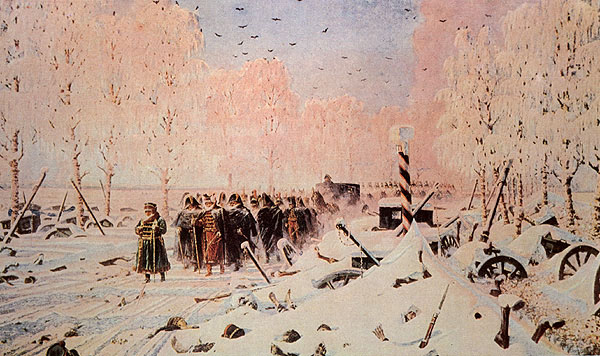
In my brief experience, fatigue is one of the most crucial aspects of the Battleground games. Having understood the basics of attacks and appreciated the issue of command and control, gaining an understanding of fatigue is the next progression towards becoming a successful commander. As the following figures show, fatigue levels play an important role in the outcome of attacks:
However, furthermore, fatigue also affects the modifier that units use when they take morale tests. The more fatigued a unit, the more it is likely to head to the rear when the going gets tough. This is especially imporant bearing in mind that units near a router also take a morale test. It is possible to see skirmisher lines or even whole formations of troops crumble having suffered only a few casualties in the last offensive phase. So how do units gain fatigue?
In the most recent patches, fatigue is accrued in two ways: by melee and by ranged fire. The latter is perhaps the slightly more common occurence and is also the simplest to explain. Ranged fire has three possible outcomes: 'Fire had no effect', which means no damage and no fatigue were inflicted; 'Fire increased fatigue of target unit', which means that although no one was killed, the enemy unit gains 1 fatigue point; and 'Loss of XXX to target unit', which not only results in casualties, but a fatigue point as well. Although both of the latter instances incur fatigue, each outcome is effective just once per phase. So a unit hit by three 'Fire increased fatigue' outcomes or three 'Loss of XXX' outcomes in a phase, will only gain 1 fatigue point. However, as both of these are different outcomes, a unit which is targeted and suffers both fates will gain the maximum 2 fatigue points in a fire phase (as well as the casualties). It is worth bearing this in mind when firing stacks of skirmisher as firing the stack in one go can only result in one outcome, whereas by firing the stacked units individually you have the opportunity to inflict both fatigue outcomes - as we have seen from the fatigue penalties, in most cases 25 casualties and 2 fatigue points is a more desirable outcome for an attacker, than 50 casualties and just the 1 fatigue point.
As mentioned, the other means of gaining fatigue is through meleeing. This type of fatigue accumulates on top of ranged fire penalties. So it is theoretically possible for a unit to become 'high fatigued' in one game turn (2 points in the defensive, points as we shall see from meleeing, 2 points in your enemy's offensive, and further points as a result of your enemy's melee). Like ranged fire, melees have three possible fatigue implications depending on the outcome. In the following tables, which shows how much fatigue is incurred by both attacker and defender, these three outcomes which can be applied to both combatants are described as 'Win with no casualties', 'Win with casualties', and 'Loss'.| FATIGUE FOR ATTACKER | Attacker | |||||||||
| Infantry | Skirmisher | Cavalry | ||||||||
| Win no cas | Win with cas | Loss | Win no cas | Win with cas | Loss | Win no cas | Win with cas | Loss | ||
| Defender | Infantry | 1 | 2 | 3 | 1 | 2 | 3 | 1 | 2 | 3 |
| Skirmisher | 0 | 1 | 2 | 0 | 1 | 2 | 0 | 1 | 2 | |
| Cavalry | N/A | N/A | N/A | N/A | N/A | N/A | 1 | 2 | 3 | |
| FATIGUE FOR DEFENDER | Defender | |||||||||
| Infantry | Skirmisher | Cavalry | ||||||||
| Win no cas | Win with cas | Loss | Win no cas | Win with cas | Loss | Win no cas | Win with cas | Loss | ||
| Attacker | Infantry | 1 | 2 | 3 | 1 | 2 | 3 | N/A | N/A | N/A |
| Skirmisher | 1 | 2 | 3 | 1 | 2 | 3 | N/A | N/A | N/A | |
| Cavalry | 1 | 2 | 3 | 1 | 2 | 3 | 1 | 2 | 3 | |

Unfortunately, despite my best efforts, these tables are still not very clear. In short, if infantry or cavalry attacks or defends against infantry or cavalry and wins with no casualties it gains 1 fatigue point; wins with casualties, gains 2 fatigue points; or loses, gains 3 fatigue points. The exception to this rule is melees involving skirmishers. Any unit (including skirmishers) which attacks a skirmisher and wins with no casualties gains no fatigue; wins with casualties gains only 1 fatigue; or loses, gains only 2 fatigue. However, for the defending skirmisher, fatigue is applied as though it were a normal formed unit melee: 1 point for a win with no casualties; 2 points for a win with casualties; or 3 points for a loss. The lesson to be learned from this is that skirmishers are best used offensively: a skirmisher that loses in an attack against another skirmisher but inflicts casualties, still suffers the same amount of fatigue as the victorious defender. So remember, in your all important skirmisher battles to keep attacking regardless of the odds: even if you know a fatigued 25 man unit is going to lose the melee against that stack of guards, in the worst outcome you will have inflicted 1 fatigue point on the entire enemy stack and you will have eliminated a skirmisher which might have been shot next turn, the destruction of which would have forced other skirmishers in the same hex to take a moral test. If your meleeing unit manages to take down 25 enemy with him, you're not only level on points, but you've also inflicted 2 fatigue points on the entire stack and disordered them so their attacking potential is halved!
While I believe the above strategy is entirely legitimate, the second issue regarding skirmisher melees uncovers what I consider to be a flaw in the game engine. You will notice that an infantry unit that melees a skirmisher and wins with no casualties gains no fatigue; wins with casualties gains 1 fatigue point; or loses gains 2 fatigue points. Fair enough, however if the roles are reversed, the fatigue advantage gained by aggressive skirmishing means that the defending infantry comes off much worse than if it had been attacking. Infantry defending against a skirmisher which wins with no casualties gains 1 fatigue point as though it had been attacked by another formed unit; wins with casualties, gains 2 fatigue point; or loses gains, 3 fatigue points. What's more in the last two instances when the infantry incurs casualties it is also disordered. Clearly, the ability of a 25 man skirmisher unit to inflict 2 fatigue points and disorder an 800 man guards unit for example, is an undesirable aspect of the game and I recommend that agreements be made before the game that skirmishers, on their own, cannot melee formed units - unless the attackers clearly stand a good chance of winning, for example they outnumber their enemy, or the formed unit is routed, or such like.
The obvious solution is not to expose your troops uneccessarily to enemy fire. The second solution, which is fortunately easier for the Allies, is to rely on firepower rather than meleeing. As players become more experienced, I think this becomes a natural tendency and meleeing for an Allied player tends to occur only in specific instances. Primarily, if there is the chance to zoc an enemy stack (and remove the entire stack from play); however the opportunity to hit a unit in the flank (which not only has an increased chance of success due to the modifer, but also increases the chance that the defeated unit will rout) is among examples of when meleeing is advantageous. Otherwise, it's advisable for Allied commanders to keep their units in line, with a hex gap between them and maintain a strong, aggressive, skirmisher line, backed up by artillery and riflemen stacked to the max, with a leader (to reduce the chance of routers disordering them).
Units can also be rested, however as the chance of recovering from fatigue is only 15%, this is not really a viable tactic. To be tested for recovery, a unit must not fire, melee, or move at all for a turn and must not suffer fatigue from enemy fire or melee. While it's not a bad idea not to move units unless you have to, leaving units 'resting' in exposed positions is invariably risky! The exception is at night when the chance is increased to 75% and in a few scenarios with specefic chances of recovery. However, that is not to say that units should not be rotated. Although it is the general tendency of French opponents to throw the kitchen sink at you (from personal experience, I'm still undecided whether this is the best tactic) the Allied commander can afford to rotate units from his front line, to those in the same formation which are in cover, to those in reserve. Though the term 'static defence' is a modern one, even in Napoleon's time, generals on the tactical defensive held back reserves so that they could strengthen their line according to enemy troop concentrations. Furthermore, as Clausewitz points out, inevitably you can only win a battle by attacking: once you've beaten off your enemies' assault, you'll need fresh troops for the counter-attack. This will bring you the victory, medals and promotion that'll win you a dowager's heart!